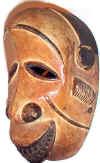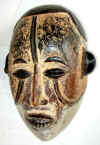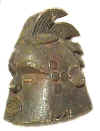 |
||||
 |
 |
TRIBAL AFRICAN ART
IDOMA
Nigeria
Living
at the confluence of the Benue and Niger rivers, the 550,000 Idoma people are
predominantly farmers and traders. They grow yams, millet and sorghum, and place these
cultivations at the heart of their festivals. As
farmers, they have a long market tradition in a region of neighboring ethnic groups who
have intermarried with one another. The Idoma believe in a creator god, but different
cults are entrusted to the various societies. The alekwu society is responsible for
the cult of the periodic resurrection of the ancestor who plays a vital social function.
The secret society of the aiuta is in charge of maintaining order; its members,
village chiefs and dance groups, remain under the control of elders. The oglinye society
groups together the royal lineage, which have the right to own the masks.
The
Idoma give their ancestors an important place in daily life. The resurrection of the dead
is an important element of their religion and the cult of the spirits of nature, Anjenu,
is celebrated through the mediation of figures preserved in shrines. In particular, a
protective spirit lives in the water or the forest and may appear in dreams. Generally
benevolent, an Anjenu favors commercial transactions, helps to cure illness and,
above all, aids female fertility. The Anjenu was invoked by men who wanted their
wives to become pregnant. Protruding conical breasts and navels are common. The face is
usually painted with white pigments -- a stylistic characteristic often shared with Ibo
people. Seated statues with one or several children are believed to incarnate fertility, a
frequent theme in the region.
Idoma people also make face and helmet masks. The bush spirit Anjenu who lives in the rivers is honored during ceremonies involving mortuary masks with white faces, silted eyes, and teeth impregnated with kaolin. The Idoma sculpt masks of various forms which relate, be it in this world or in that of the beyond, to the exercise of justice. The manifestation of masked ancestors signifies their presence into the world of the living. The spirits’ return is, thus, the key element underlying Idoma religious thoughts. Occupying an eminent position at the society’s very heart, the ancestors are special mediators of relations between the Idoma and the supernatural forces that surround them. They also incarnate the memory of the Idoma people, for their apparition serves as pretext for the public recital of their genealogies and history. Face masks are worn by dancers during funerals, typical for them are specific shape of scarification, open mouth and smooth coiffure.